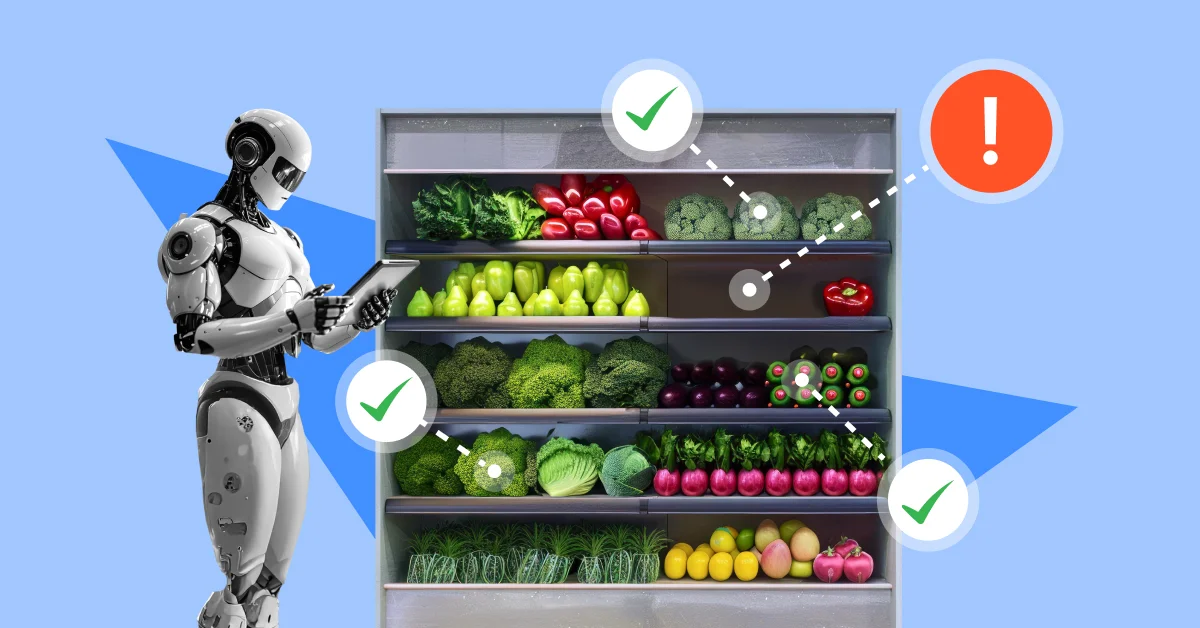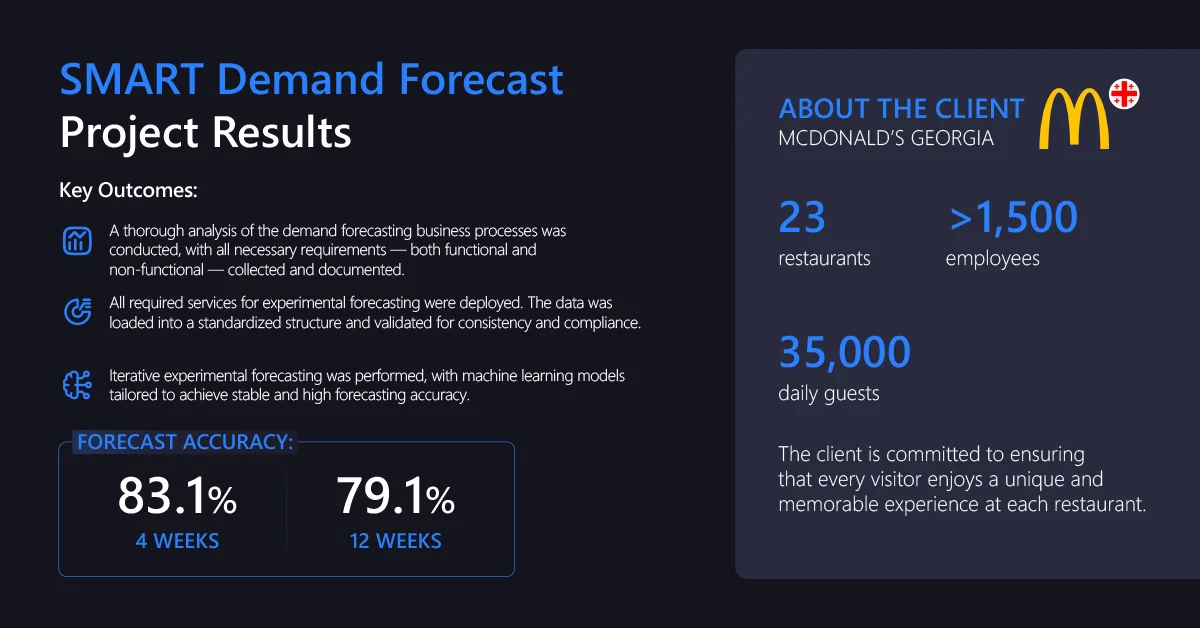26 Jun 2025 10 MIN READ
How AI in Retail Helps Optimize Inventory and Prevent Write-offs: No Time to Lose, Time to Earn

Globally, retail faces two major challenges that lead to profit loss and, consequently, slow down growth. Both result from inventory management errors: overstock and out-of-stock.
According to research by IHL Group, in 2023, the mismatch between retail inventory and actual demand in the United States was estimated at $1.77 trillion — exceeding the combined GDP of Latin or South America’s retail sector.
Of this amount, $562 billion is attributed to excess stock that retailers try to sell at least at cost price or even lower. However, some of this inventory must still be written off, meaning it is discarded.
European retailers face similar problems. According to the reputable media outlet Internet Retailing, in 2023, British retailers were forced to sell nearly half (48%) of their products at discounted prices due to overstock. Meanwhile, the influential outlet Customer Think estimates that annual losses due to stock-outs amount to approximately 4% of the average retailer’s profit.
How Companies Lose Money Due to Poor Inventory Management
Both overstock and out-of-stock situations are caused by inaccurate demand forecasting. Why? Because demand forecasting is the starting point of the entire supply chain system. It triggers the planning mechanisms for procurement, production, and logistics. Even a small error at this stage leads to a rapid accumulation of operational costs at every subsequent link in the chain.
Let’s take a closer look at how this works.
Stop Wasting Money: Why Overstock Is a Major Profit Killer for Retailers
If a company overestimates demand and brings in more goods than consumers are willing to buy, it primarily results in inefficient resource use. Instead of being a strategic investment that drives growth, money effectively gets “frozen” on warehouse shelves.
But this is not the only loss caused by overstock. One must also be prepared for unpredictable growth in operational expenses — in particular, warehousing and logistics costs.
At the end of 2022, Bloomberg published striking figures: despite all efforts to sell excess goods, nearly 8% of them worldwide ultimately become waste. This means that each year more than $160 billion worth of unsold products ends up in landfills.
Out-of-Stock: Why It’s Dangerous for Business
On the other hand, out-of-stock means lost sales. But, as with overstock, these losses — though obvious — are not the only ones. Frequent out-of-stock situations directly lead to a loss of market presence.
Perhaps the most painful consequence for businesses in the era of customer-centric service is a decline in customer loyalty.
According to research by Customer Think, 37% of consumers who don’t find the product they need on the usual store shelves try to purchase it elsewhere — either on their way home or online. In most cases, these customers are lost to the business forever.

How Retailers Can Optimize Inventory Levels and Stop Losing Money
How can retailers organize their business processes in a way that enables them to respond quickly to ever-changing consumer expectations in each individual store? How can they stabilize supply chains to avoid losses and make informed business decisions regarding supply planning?
The answer lies in learning how to forecast demand accurately.
In today’s reality, this is only possible by transforming supply chain business processes using innovative technologies.
A compelling example comes from a government-led demonstration experiment conducted in the Oita and Fukuoka prefectures in Japan. Its goal was to reduce food waste by optimizing the supply chain through AI-based demand forecasting, while also increasing sales.
As a result, supermarkets involved in the project were able to boost sales of the participating products by nearly 20% thanks solely to accurate forecasting, including the identification of hidden demand.
Why are innovative technologies essential here — and which AI capabilities make the biggest difference? Let’s break it down.
Using AI to Analyze Historical Sales, Seasonality, and Trends
The key value of artificial intelligence in generating accurate demand forecasts lies in its ability to process vast volumes of data in a very short time. Modern algorithms factor in numerous relevant variables, calculate correlations, identify seasonal fluctuations, and detect emerging trends.
Most importantly, all this is done with a minimal margin of error — something that’s inevitable with manual calculations. Fewer errors mean fewer losses.
How AI in the Retail Industry Helps Businesses Reduce Waste
The primary reason for write-offs in retail is unsold goods — that is overstock resulting from inaccurate demand forecasts. And AI-powered technologies are the most effective tool for elevating forecasting to a new level of precision and efficiency.
Moreover, AI-based demand forecasting solutions work equally well for reducing waste across products with varying shelf lives. For items with shorter expiration dates, it’s simply important to refresh the forecast more frequently.
One example of such a solution is SMART Demand Forecast — an AI-powered demand forecasting tool. It supports forecasting at various levels of aggregation and for different planning horizons.
In addition, if a customer has a non-standard requirement that needs to be factored into the forecast, SMART Demand Forecast allows for manual input. This enables businesses to add extra details on the fly and adapt quickly to the demands of a fast-moving, ever-changing market.
How the SMART Demand Forecast Solution Helped the McDonald’s Georgia Team Improve Forecast Accuracy
A notable example is the implementation of SMART Demand Forecast across a network of 23 McDonald’s quick service restaurants in Georgia, which serves 35,000 visitors daily.
Before partnering with SMART business, the company generated demand forecasts on a monthly basis for the entire network. This level of granularity often led to additional logistics costs due to the need to redistribute ingredients between locations. Eliminating this issue and minimizing operational expenses became the key drivers behind McDonald’s Georgia’s decision to upgrade.
Thanks to the deep expertise of the implementation team, it was possible to identify the optimal set of factors influencing forecast accuracy for this business. As a result, weekly forecasting was introduced for each individual restaurant.

As a result, the project achieved — and even exceeded — its target KPIs:
- 83% forecast accuracy for each restaurant based on weekly data aggregation over a 4-week period.
- 80% forecast accuracy for each restaurant based on weekly data aggregation over a 12-week period.
- An average forecast deviation of no more than 5%, which aligns with global business standards.
Thanks to this project, we significantly improved demand forecasting accuracy across all our locations. And once we saw the initial results it became clear that the project would pay off very quickly.
 Giorgi Asatiani Head of BI & Data Analytics, BI & Data Analytics Department, McDonald’s Georgia
Giorgi Asatiani Head of BI & Data Analytics, BI & Data Analytics Department, McDonald’s Georgia
How to Make Data Work for Your Business
So, if your company not only generates data but also actively aggregates it thanks to the capabilities of its IT ecosystem, don’t delay the next step — implementing AI-powered solutions.
AI is what helps your IT products become better versions of themselves, turning data into a real driver of profitability. First and foremost — by significantly increasing the speed of data collection and processing.
The Data-Driven Approach in Retail
A data-driven approach is about making data work for your business. And deciding which tasks to delegate to AI is always an individual choice.
One of the most popular applications lately has been AI-based chatbots and virtual assistants — tools that have significantly enhanced customer service experience.
According to Promodo experts, 80% of retail and eCommerce companies already use or plan to implement AI chatbots in the near future. They predict that by 2030, AI will handle 80% of all customer interactions.
AI assistants can also be highly effective in retail operations — particularly in stock write-offs and goods receiving. And that’s not to mention their vast potential in sales and marketing.
AI in Retail: Pros and Cons
In today’s fast-paced market, success in retail means being able to account for a vast number of factors. Doing this effectively and accurately without modern tools and approaches is virtually impossible — so there’s no point clinging to trendy myths.
Myth 1: Good analysts can forecast better than AI
Here’s an example: most retailers in Ukraine still don’t account for air raid alerts in their forecasts — periods when shopping malls are closed. And it’s not because they don’t want to, but because they simply don’t know how. As a result, they suffer unnecessary losses.
The problem lies in traditional statistical models — they rely solely on historical data and cannot factor in future events. That’s why it’s crucial to transform business processes, particularly by implementing AI-powered forecasting systems to avoid becoming a victim of “unforeseen” circumstances.
Let your analysts focus on strategically important tasks instead.
Myth 2: The implementation of AI in retail may lead to mass layoffs
This myth has long been debunked by successful companies around the world. The fear that AI will replace human employees is a common reaction during any wave of technological innovation.
At one time, accountants were wary of ERP system adoption. In fact, resistance to change was among the reasons for two infamous digital transformation failures — at Nestlé and Hershey — alongside misalignment between existing business processes and the standardized ERP requirements.
Today, however, few would question the role of ERP in optimizing operations and boosting performance. ERP has become a foundation for business success. Likewise, the demand for qualified accountants hasn’t gone away — but the expectations for their skill sets have evolved. The same applies to AI solutions: you shouldn’t worry about AI taking your job — instead, focus on mastering the skills needed to work with it.
Myth 3: AI in retail is costly, and its benefits are hard to measure
BrandWagon shared findings from the “Intelligent Retail” study conducted by KPMG International.
According to the report, 55% of retail companies that adopted a data-driven approach reported a return on investment (ROI) from AI-driven technologies in the range of 10–30%. What’s more, respondents also reported a 33% increase in business efficiency and up to 67% cost savings in the processes where AI was implemented.
So today, AI in retail is like a modern gadget: you can operate without it, but achieving success in today’s market without it is incredibly difficult.
